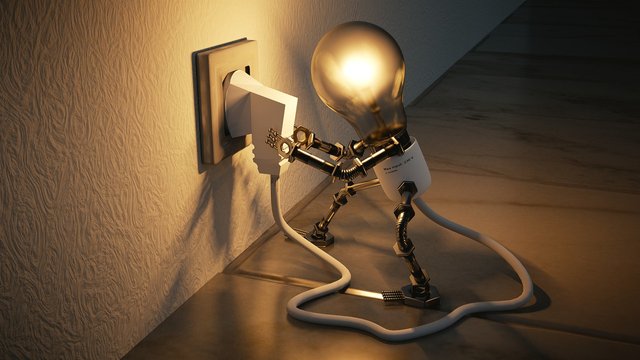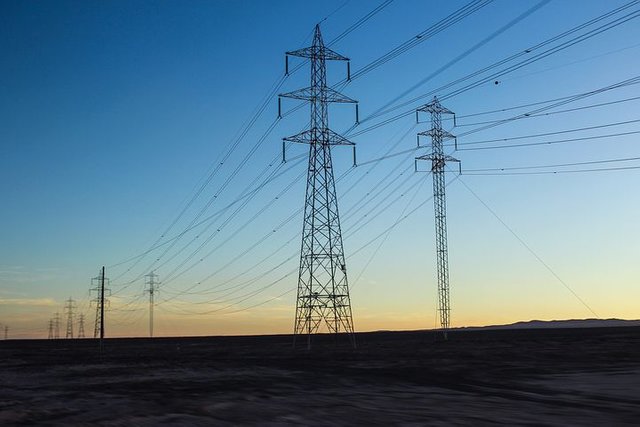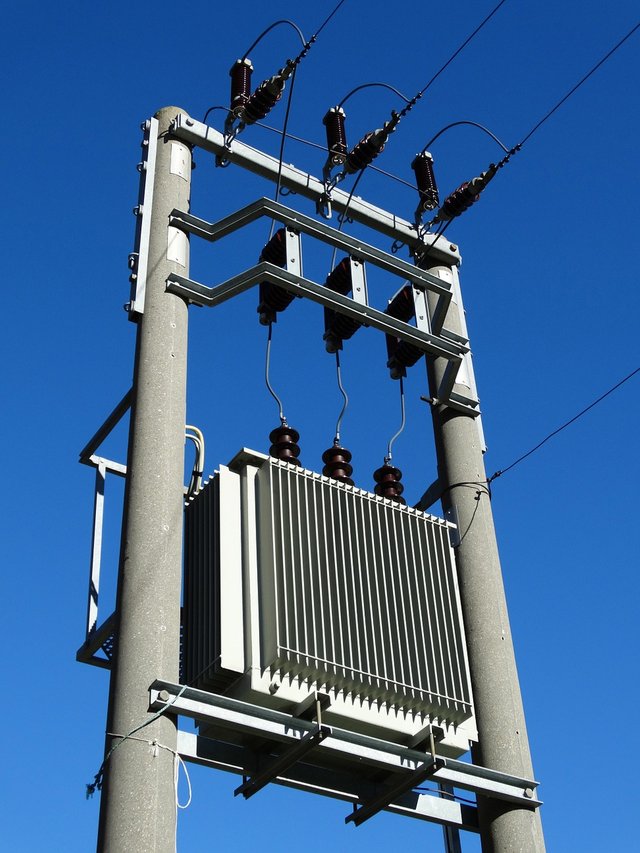Principles of Power System: A dig into Generation, Transmission and distribution of Power
The discovery of electricity can be dated far back during the days of the great scientists which every now and again deserves lifetime accolades . The generation of electricity is made possible in large amount today due to the relentless effort and researches leading to the discovery of the electromagnetic induction by Michael Faraday. Now, electricity is largely generated in numerous ways and has grown to be the basis of comfort, providing our daily power need.

Image Credit: Pixabay Commons
You turn on the lighting switch and light comes on. Isn't this amazing? So, why not let's have a brief journey into the principles of power system. Trust me, you'd definitely have a nice ride.
To understand the principles of power system, the concept of power generation, transmission and distribution will be required. My previous post was on the concept of solar technology, an alternative way of generating power. Here, I have the conventional way through which power is generated, transmitted and disturbed to consumers.
In the real sense, the principle of Power system goes beyond just generating, transmitting and the distribution of power but involves adequate process of planning, control, stability and protection of the system which I will refer back to later in the discussion. But now let's get to know the process involved in the power generation, transmission and distribution.
POWER GENERATION
Power generation basically involves the conversion of forms of energy into electricity. This is carried out in different ways using mechanical and electrical devices to convert one form of energy to the other. Nigeria as a case study, uses two primary sources of energy for electricity generation. The Thermal ( Gas, coal etc.) and and the hydro-power. The gas thermal basically burns gas to heat water, generate steam which is used to drive turbine connected to an electric generator producing electricity as a result of the action of electromagnetic induction.
Electromagnetic Induction is the concept of generating electricity in which flow of electrons is produced in a conductor (electric generator) cutting across a magnetic field. You can learn more on electromagnetism on a previous post here. Energy from coal is also another source employed in generating electricity. Similar to the gas thermal, heat is released in coal powered generation station by the combustion of coal, in which is used to convert water into steam in the boiler at high temperature and pressure which is then passed through turbines to drive the generator (alternator) giving output as electric energy. On the other hand, the hydro-power employs the kinetic energy of moving water to drive a turbine connected to the generator. This action of generating power are achieved in a power station where both mechanical and electrical equipment are installed to perform the operation.
 Power Generator.[CC0] , from Pixabay Commons
Power Generator.[CC0] , from Pixabay Commons Power is then generated from the electric generator at a voltage of 11KV/16KV at the generating station or the so called-power plant, and is then step up to 330KV by the use of step-up transformers for transmission. Now, you should ask me why the generated power is being step up to such an higher value of voltage. Simple though!. We are about to transmit power to different transmission stations widely far away from the generating stations. So, in order to efficiently transmit this power over long distances, the need of high transmission Voltage is required, a way of minimizing the power loss as well.
POWER TRANSMISSION
Power Transmission involves the evacuation of generated power from generation stations to the distribution stations. Step-up transformers convey generated electricity to switch yards from where it is evacuated at very high voltages (330 KV in the case of Nigeria) and transported through high-tension wires for delivery to transmission stations. Transmission stations are equipped with circuit breakers, busbars, transformers among other electrical equipment which makes up the switchyard.
 Transmission Line.[CC0] , from Pixabay Commons
Transmission Line.[CC0] , from Pixabay Commons As Power is transmitted at high voltage, it is accompanied with low current which reduces the resistance offered by the conductors when power flows through. This made possible the use of light-weight cables for power transmission as seen on transmission towers, making transmission of power at high voltage economical
At the transmission station where 330KV is received, step-down transformer are used to step this voltage down from 330KV-132KV and further transmitted to substations receiving 132KV. Sub-stations receive the 132KV and there, it is further stepped down to 33KV for the distribution stations.
POWER DISTRIBUTION
Power distribution is the aspect which ensures delivery of power to consumers (Home & Industry). Power received from transmission station are here further step-down from 132KV to 33KV/11KV (high tension Voltage) and conveyed to towns and cities. The distribution level of voltage (33KV/11KV) are distributed to distribution transformers located within the cities from where it is further step-down to 415V/240V for domestic use.
 Distribution Transformer.[CC0] , from Pixabay Commons
Distribution Transformer.[CC0] , from Pixabay Commons Distribution transformers gives an output of 415V of three phase (Red, Yellow & Blue) an a neutral circuit which is then channeled to feeder pillar and distributed to consumers either as 415V-3phase or 240V single phase use. The distribution sector of the power system also oversees the of maintenance and management of power use and it's billings.
Classification of Power System Voltage
• Low Voltage: Voltage less than 1KV (1000V) are regarded as low voltage in power system which are mainly used for connection between residential and the utility.
• Medium Voltage: This we have between 1KV -33KV used for distribution across cities.
• High Voltage: Voltage found between 100KV to about 230KV are categorized as high Voltage and are mainly used for transmission of bulk quantities of power.
• Extra high Voltage: Voltage over 230KV to about 800KV used for long distance transmission are regarded as extra high voltage.
• Ultra High Voltage: Ultra high voltage is the power voltage of 800KV and above

Now, it's good I let you know that these three aspect of power system works in synchronism, forming a network of electrical grid to achieve stability and reliability of the system. As power is generated, it is transmitted and distributed for consumer use. Hence, there's need for adequate control and monitoring of the system so as to ensure that the electricity generation matches the demand.
This is what I mean; Using the Nigeria scenario, Power is generated at 5OHz, a frequency level which must be maintained to ensure stability of the grid. The Frequency must be maintained and be kept close as possible to this standard value of frequency. Like I said, the generation must match the demand at every instant of power transmission. If there a mismatch between power generation and demand, the frequency tends to move away from the nominal value (50Hz).
The frequency of the system changes as load and generation changes. During a severe overload, i.e. when electricity demand is greater than generation, the system frequency will decline and also when generation is greater than demand, it causes the system frequency to rise. So it is necessary to keep a balance between generation and demand of power to avoid collapse of the system. And this takes us to the concept of load shedding.
Still with the Nigeria scenario. Nigeria as a country has a population close to 200 million but could only manage to produce a generating capacity not more than 10MegaWatt of power. Definitely this capacity isn't just enough to cater for the population. In this case, Power generated is cautiously managed so the limited power generation will be available for certain level of demand.
When generation matches the demand, the grid frequency is at nominal value of 50Hz. When generation goes above demand at certain point, the frequency comes greater than 50Hz, then more load is being supplied to consumers. Also in the case when we have demand to be greater than available power, this results in decline in the frequency which may lead to system collapse causing total blackout. When demand goes higher than generation, the effect is felt on the generator as a result of overheating which may cause inter-turn short on the generating systems. When demand goes above the generation is when load to consumers is shed to compensate for frequency adjustment for attaining normalcy. Power is being shed as a result of limited generation, affecting the stability of power across consumers, making power not available everywhere at a time. Hence, like I pointed out earlier, adequate control measure is one of the processes that ensures reliability of power system.

Talking about control in Power System, it ensures the maintenance of acceptable level of frequency and voltage of the power grid. Automatic Voltage Regulator (AVR) and speed governors are employed as mechanisms of control system
by providing constancy of the generator terminal voltage and the control of speed during normal, slow or rapid changes in load.
Adequate control ensures stability of the system i.e. ability of the system to return to stable condition after having being subjected to some form of disturbance. Having a stable system ensures power system security, provides robust performance, and have a way of maximising the plant availability under all conditions. Not just that, power System stability ensures proper management of voltage fluctuations and ensures the system reliability.
I want to believe you'd have been wondering if I won't be talking about protecting the system. Definitely, it's an important aspect which requires adequate concern. Fault do occur during the transmission of power from generating station to load centres through transmission line which may cause abnormal operation of the system resulting in damage of power equipment and loss of supply to consumer. Hence, the need for protective devices in power system cannot be neglected.
Power systems are protected by installing protective devices on the system to protect equipment from accidental conditions which may cause any form of damage to the equipment. Protective devices including relays, circuit breakers and other forms of protection such as earthing are done on power system for system reliability.
In summary, the principle of power system involves proper planning which ensures good coordination of generation, transmission and distribution of power. Adequate control ensuring stability, as power is consumed as generated and the protection of the system against equipment damage. All these are principles employed in power system to ensure system reliability.
I hope it's a time well spent reading through. A nice ride I believe you had. Thanks for stopping-by!
REFERENCES
If you write STEM (Science, Technology, Engineering, and Mathematics) related posts, consider joining #steemSTEM on steemit chat or discord here. If you are from Nigeria, you may want to include the #stemng tag in your post. You can visit this blog by @stemng for more details. 
I'm a proud member of @promo-mentors where you get mentored and guided on how to make quality posts on steemit amongst other benefits. Do join us on discord. We anticipate your arrival.

Amazing post I learnt alot and your presentation was great. Take for Instance I didn't know that there must be a balance between demand and supply of power. That means when there is a reduction in load there is need to supply elsewhere or remove some generating stations from the grid right?
When there's more power generated, more supply is given out which is also monitored, cause a case of Nigeria where the generation has not come any close to catering for the population. Balance of the system has to be ensured. I'm glad you found this post educating. Thanks
Hi! This is jlk.news intelligent bot. I just upvoted your post based on my criteria for quality. Keep on writing nice posts on Steemit and follow me @jlkreiss to get premium world news updates round the clock! 🦄🦄🦄
Hello! I find your post valuable for the wafrica community! Thanks for the great post! @wafrica is now following you! ALWAYs follow @wafrica and use the wafrica tag!
Nice digging. Power system will remain forever relevant.
Kudos @olajidekehinde
But there several drawbacks for the transmission. There are situations this high tension wire fall on people and cause several death. How do u tend to stop that? Cant it be transfered underground.
Surely Power is transmitted underground which is much safer compared to overhead transmission but the cost of executing underground transmission has been the setback to having this type of transmission in this part of the world. Underground transmission is widely practised in developed nations
Electric power is a blessing to mankind, @tundevet chances that a high tension line falls on people is one out of ten million possibility. And cost of transmiting underground is very very expensive compared to overhead transmission. This is a comprehensive article anyone can go through to understand electric power principle. Kudos
Michael Faraday the king himself.
I wonder what would happen if nobody discovered electricity. Great job educating us on power generation.
This is a sound one...
You went pretty deep to explain this processes.
Kudos
Hi @olajidekehinde!
Your post was upvoted by utopian.io in cooperation with steemstem - supporting knowledge, innovation and technological advancement on the Steem Blockchain.
Contribute to Open Source with utopian.io
Learn how to contribute on our website and join the new open source economy.
Want to chat? Join the Utopian Community on Discord https://discord.gg/h52nFrV